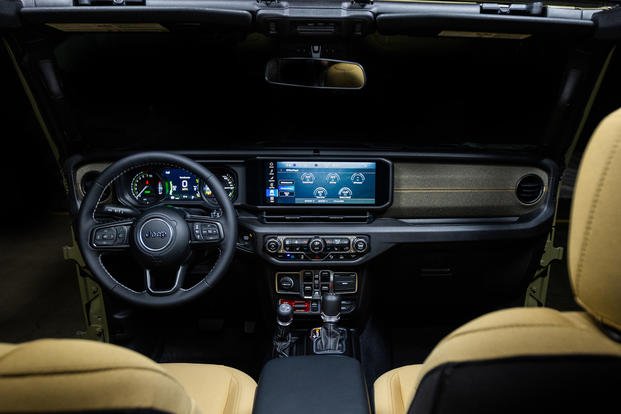
By Scott Murdock
Is that a fresh coat of Army green paint I see?
On Tuesday, Jeep announced a special-edition 2025 Wrangler to commemorate the original Jeep, the 1941 Willys MB. The new Willys ’41 package features a hybrid 4xe drivetrain, olive drab paint, tan cloth seats, 33-inch tires, a locking rear differential, steel bumpers and Willys branding. A tan cloth top is on the way, too.
“Eight decades after cementing a reputation for all-terrain capability, straightforward design and tough versatility, the spirit of the original Willys MB lives on in everything we do at Jeep brand,” Bob Broderdorf, senior vice president and head of Jeep North America, said. “The new 2025 Jeep Wrangler 4xe Willys ’41 is a testament to that heritage. It’s a celebration of our past that inspires us, while we keep pushing the boundaries of capability and innovation.”
It looks cool, but the origin story behind it is even cooler.
You see, a long time ago, a company named Willys was riding Depression-era economics down a long and lonely road to bankruptcy. All of a sudden, a shiny government contract appeared ahead: In July 1940, the U.S. military challenged 135 manufacturers to build the best lightweight, off-road reconnaissance vehicle in the world, to help prevent the Axis powers from steamrolling every last bastion of freedom in their paths.

Willys, Ford and Bantam answered with vehicle prototypes that measured less than 75 inches long and 36 inches high, weighed less than 1,300 pounds and could tackle any terrain in their path with four-wheel drive.
At the end of testing, Willys reigned supreme with the MB Jeep. The previously struggling company churned out more than 360,000 MBs from 1941 to 1945. Ford chipped in by building another 280,000 nearly identical GPWs, as Hemmings points out.

According to the Jeep gurus at Kaiser Willys, the 2.2-liter Go-Devil engine (automotive terms were so much cooler back then) could put along at 65 mph and cover 285 miles on a single 15-gallon tank of gas. Power reached all four wheels and their six-inch-wide tires via a three-speed transmission, a two-speed transfer case and Dana differentials at each end.
The Jeep earned a bulletproof reputation for reliability on the battlefield. It went everywhere American service members went, including the foggy English countryside, the tropical islands of the Pacific, the sands of North Africa and the snow of Bastogne. You name it; the Jeep was there, running without so much as a misfire. It carried ammunition to front-line troops, whisked commanders across the battlespace and shuttled bomber crews to and from their aircraft. It didn’t win World War II single-handedly, but it arguably deserves as much credit as the B-17 and M1 Garand, which is pretty elite company.

Needless to say, the enemy was stunned when Jeeps started rolling through Rome, Paris, Iwo Jima, Okinawa and finally Berlin. It was the greatest military vehicle in the world — and the peculiar thing is that the vehicle Jeep built during that fateful war didn’t actually look anything like this Jeep.
The Wrangler 4xe Willys ’41 Special Edition isn’t as simple as a tractor or stripped down to the bare essentials. It has a hybrid powertrain that I suspect requires more computing power than the entire U.S. military possessed during World War II, save for the Manhattan Project’s 1,800-square-foot computers.

According to the spec sheet, this rig weighs more than 5,000 pounds. There are LED lights in the cupholders. You can listen to satellite radio through nine speakers and a subwoofer. The computer hosts a suite of electronic safety nannies that I suspect would not allow the kind of hijinx that driving on the front lines of World War II required.

Is the 2025 Wrangler 4xe going to be a capable off-roader? I have no doubt. But it’s worlds apart from the Jeep that started it all.
The sad reality is that manufacturers simply can’t build vehicles like that anymore. There are too many do-gooder politicians, too many boardroom MBAs who’ve never lifted a hood and too much red tape. Even if manufacturers had free rein, we’ve all gotten too reliant on Apple CarPlay and remote start to buy an open-topped tin can with double-digit horsepower and canvas pads for seats. The Jeeps of yesterday are just that: yesterday’s Jeeps.

So this Wrangler is just a tribute; you’ve got to believe me. Horrors of war aside, part of me wishes you and I were there to see the original Jeep in its prime, bouncing off bomb craters and dodging Mauser fire. But that’s just a matter of opinion.
Courtesy of Military.com





